I was wasting a lot of time thinking about a cool and engaging way to start this ConvertKit review.
Then it hit me…
Chances are not many people are going to read this and are instead going to jump straight into the review, so why waste my time and theirs, right?
So let’s get this party started, shall we?
Contents
- What I like about ConvertKit
- ConvertKit features
- ConvertKit for beginners
- ConvertKit pricing
- How to migrate to ConvertKit
- Frequently asked questions
- Final thoughts: ConvertKit review
Disclosure: You should always assume that pretty much every link on this site is an affiliate link, and if you click it and buy something you like, I’ll earn some money to help me buy a DeLorean, build a time machine, and travel back to the 90s so I can watch Hey Arnold! and eat Dunkaroos again.
Email marketing and automation tool to grow your blog without having to be in front of your computer all day.
What I Like About ConvertKit
Let’s start this ConvertKit review with the things I like the most about it.
They Deliver Your Stuff
Honestly, it doesn’t matter how many cool features an email service provider (ESP) has if my emails aren’t getting delivered or keep hitting my subscribers’ spam box or Promotions tab.
Email deliverability is the main reason I’ve stayed with ConvertKit after trying a few other ESPs.
Running a huge sale or course launch and have my emails end up in my leads’ spam box?
Lol.
No, thank you.
Don’t want my subscribers’ email service pulling an Ariana Grande on me.
“You like my spam box?”
“Gee, thanks”
“Just put your email there”
Here’s what ConvertKit’s deliverability rate was in July 2020 for the most popular mailbox providers:
| Provider | Deliverability Rate |
|---|---|
| Gmail | 99.47% |
| Yahoo | 99.86% |
| Hotmail | 99.85% |
| AOL | 99.87% |
| Outlook | 99.86% |
You Can See What You’re Doing
Visual automations are one of my favorite ConvertKit features.
When I was in college getting my industrial engineering degree, I used to always draw the problems before attempting to solve them.
This made even super complex problems easier to visualize and solve.
So whenever I hear something has a visual editor, I get more excited than Kel does for orange soda.
With ConvertKit’s visual automations, you can quickly and easily set up complex “if this, then that” rules.
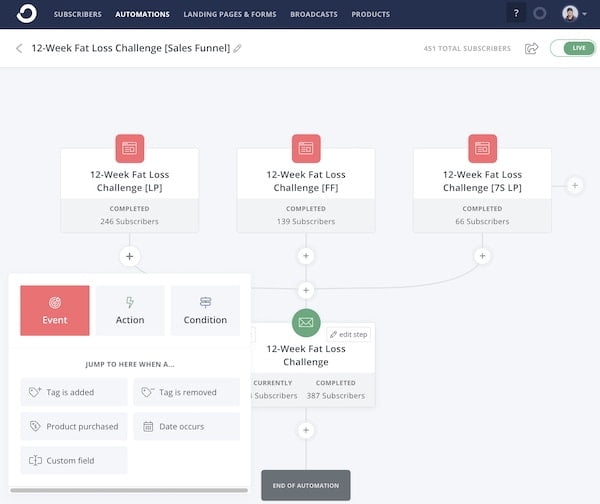
Minimal and Easy-to-Use Interface
There’s so much to learn and do when running a business, especially during the early stages.
The last thing you want is to waste several days trying to figure out how to use yet another platform.
ConvertKit is pretty simple and straight forward, which is cool for those just learning how to start an email list.
One example is their email editor.
All of the emails within a sequence are listed on the left sidebar, so you can quickly switch between emails and edit them.
With my previous ESPs, I always had to x out of an email and make several clicks to open another one before I could start editing it.
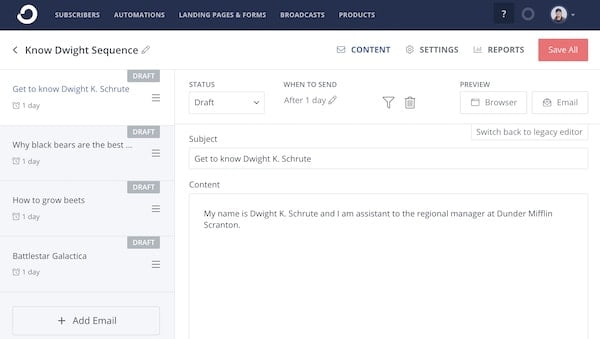
If you’ve never used an email service provider before, this might not seem like a big deal.
But trust me, it is a HUGE time-saver.
You Can Sell Your Stuff
ConvertKit offers ConvertKit Commerce in both their free and paid plans, so you can easily sell your digital products.
This is actually new, though… so I haven’t really tried it yet.
But if you’re using ConvertKit, you don’t have to spend money on another monthly service like SendOwl to sell your digital products.
Well done, ConvertKit, well done.
ConvertKit Features
Let’s take a more in-depth look at the features ConvertKit offers.
1. Email Editor
As I mentioned earlier, ConvertKit’s editor is very minimal and allows you to edit all your sequence emails without having to leave the editor.
Inside the editor, you can also:
- Select when to send emails (which days, how long after the previous email, and what time of day)
- Preview your emails
- See reports on how each email inside the sequence is performing (open rate, click-through rate, etc.)
- Choose different email templates
Some people do believe the editor it too minimal, but I think it’s okay as it is.
Here’s the thing…
Simplicity = Better Deliverability
Having your emails land in your recipients’ inbox used to be pretty easy a few years ago.
But with the growth of email marketing and online businesses in general, the number of scammers has also increased.
This has led email providers like Gmail and Outlook to set very strict spam filters.
Images, links, and certain keywords like “bonus,” “weight loss,” “buy now,” and “sale” can trigger spam filters.
That’s why many marketers nowadays prefer to send plain text emails.
Sure… they might not look as fancy, but they get delivered.
Now, this doesn’t mean that you can’t add images, links, or any of those words inside your emails.
If that were the case, there’d be no point in sending emails.
But it’s good to keep those things to a minimum.
Content > Design
Another reason I like the simplicity is that it makes your CONTENT the main focus of the email.
A lot of bloggers use fancy designs to make up for their crappy content.
At the end of the day, people subscribe to your list because they find value in your CONTENT, not because your website’s design is beautiful.
Plain Text Feels More Personal
People are looking for others they can trust and connect with.
They’re tired of getting yet another automated email from a company that only wants their money.
Don’t you hate it when you call somewhere and instead of a real person, you get an automated answering service telling you to “press 1 for Español?”
A simple text-based email feels like you’re getting an email from a friend.
2. Subscriber Management
ConvertKit uses what they call “tags” to manage your subscribers.
For example, you can create a tag for users who click a link in your email and showed interest in your products.
This way, you can send them more targeted emails and entice them to complete the purchase.
ConvertKit also allows you to see each subscriber’s data, such as:
- Which emails they’ve opened
- Which links they’ve clicked
- If they’ve made a purchase
- Which form they used to subscribe to your list
- And more
3. Segments
Segments allow you to separate email subscribers into smaller segments based on set criteria.
This is basically used to deliver more personalized/relevant marketing emails to your subscribers based on interests, purchase history, location, etc.
A lot of lazy bloggers just send the same emails to everyone on their list.
Minimal effort leads to minimal results.
If you want the most return on investment (ROI) using segmentation is probably a good idea.
In fact, marketers who use segmented campaigns can see as much as a 760% increase in revenue, according to data gathered by Campaign Monitor.
For example, on my main fitness site, I cover topics like nutrition, muscle building/bodybuilding, and general weight loss.
Not everyone interested in losing weight wants to become a bodybuilder or cares too much about optimizing their workouts to get swole.
I would get little ROI if I sent those interested in weight loss the same emails, content, and sales pitches I send those interested in bodybuilding.
In fact, they could even see me as an annoying spammer and eventually unsubscribe from my list or report me as a spammer.
So don’t be lazy, use segments.
Tags are mostly used to categorize people. Segments, on the other hand, are mostly used to organize your tags, forms, and sequences – like a folder or saved search.
4. Forms
ConvertKit has some professional-looking form templates you can quickly edit and add to your site.
These are the display formats they have:

- Inline – this is my favorite type of form since it’s the least intrusive. Inline forms are displayed within your blog posts.
- Modal – this format will cover the entire screen so visitors can’t miss it. I hate being this intrusive, though. But they do have a high conversion rate. You can also choose when you want it to show up. For example, when a user is about to leave the page, after they’ve scroll to a certain percentage of the page, or after the visitor has been on the page for a number of seconds.
- Slide in – this form slide in from the bottom right or left. Just like the modal form, you can select when you want it to show up.
- Sticky bar – small form that stays on your top bar. Great for those like me who hate intrusive pop-ups but still want to give visitors a quick way to subscribe.
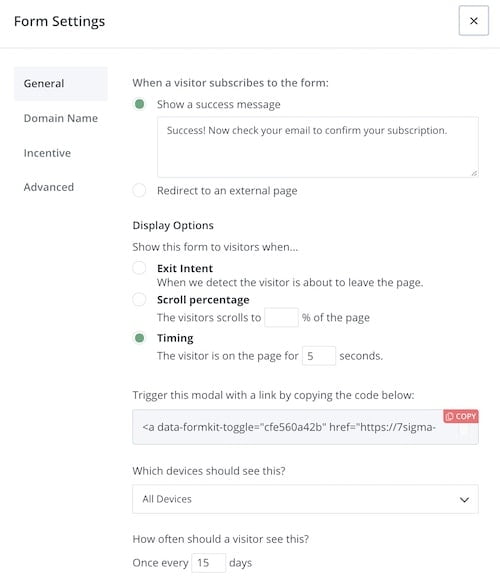
5. Landing Pages
A landing page is a web page designed specifically to convert visitors into leads.
While other pages on your site typically encourage visitors to click other links and keep exploring, a landing page doesn’t have any navigation links or distractions.
It only includes a form for your visitor to subscribe to your list, podcast, webinar, eCourse, or whatever you’d like, really.
A lot of “big” bloggers will try to sell you tools like LeadPages ($27/month) or ClickFunnels ($97/month) to create landing pages.
Their excuse is often that these landing pages “look more professional” so they’ll help you “make more sales” and end up paying for themselves.
Lol.
Even if you didn’t like the templates offered by ConvertKit, you could simply build your own just like you would any other page on your site.
You’d only have to make sure that your theme allows you to disable elements, such as the navigation menu, footer, sidebars, etc.
Another option would be to pay a web designer to do it for you, which would still be cheaper than having that LeadPages or ClickFunnels monthly payment.
They only push these tools because of their high and recurring affiliate commissions.
If your theme doesn’t allow you to disable elements, the one I recommend and use in all of my sites is GeneratePress. (my review)
When I first started with ConvertKit, they only had a few landing page templates, but now they have A TON more and look really nice.
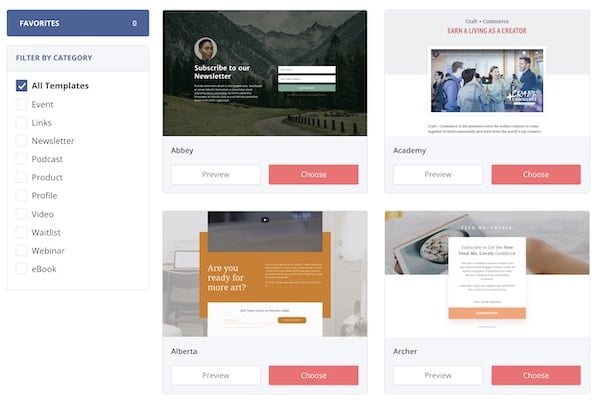
They have templates for events, links, podcasts, products, webinar, eBooks, and more.
6. Automations
Automations are what will save you the most time, and they’re honestly why email marketing is so good.
Once you’ve created an automated sequence, you can just sit back, relax, let your subscribers go through it, and make sales without having to lift a finger.
Automations are basically sequences of emails that are sent automatically when a subscriber takes an action or another condition is met.
For example, you could send an email 3 days after someone looked at your product but didn’t make a purchase.
You can create your own automations or use one of the several templates ConvertKit offers.
They have automations for evergreen product pitches, product launches, webinars, follow up with customers who don’t purchase, and more.

This is another thing ConvertKit didn’t have when I first joined them.
This would have saved me a ton of time as well.
7. Support
Whether you’re a beginner or a more advanced email marketer, it’s always nice to know you have good support in case any issues arise.
ConvertKit offers email and live chat support from 8 am – 8 pm eastern time, 7 days a week.
ConvertKit for Beginners
As I’ve mentioned several times already, ConvertKit didn’t have a lot of the features they now have when I was first starting out.
They didn’t have a free version, their form and landing pages templates where kind of… meh… and they didn’t have automation templates.
It’s nice to see ConvertKit putting more interest in beginner bloggers and helping grow instead of making them have to start with another ESP and then move to ConvertKit later on.
ConvertKit’s simplicity and minimal user interface make it super easy for beginners to get started.
Visual automations and the amount of landing page, form, and automation templates they have are total time-savers.
And now you can even sell your stuff without having to pay $10-50 for a checkout service like SendOwl?
Dang, ConvertKit’s getting their poop together.
They also have a great resource base with video trainings and are constantly doing webinars teaching entrepreneurs how to scale their business.
Pretty cool seeing a company that actually cares about the success of its users and creators.
ConvertKit Pricing
There’s no denying that ConvertKit is a little more expensive than other email service providers.
Their cheapest plan – Creator – which is what I use, starts at $30 per month for 1,000 subscribers.
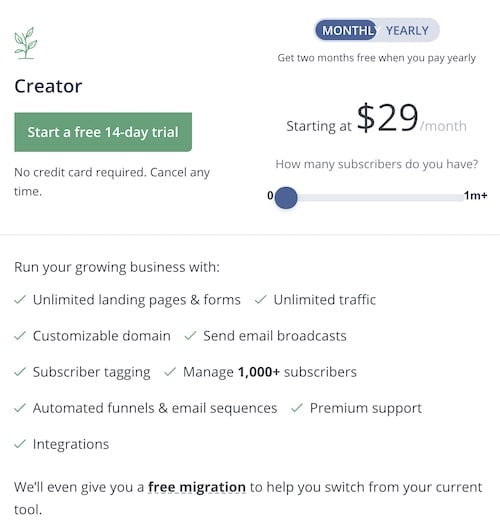
Here’s the thing, though…
Email service providers work like shared WordPress hosting providers.
“What does that mean, Christian?”
This means that, unless you pay for a dedicated IP (which can be an extra $50+ per month), you’ll be put in a server with several other users.
Since everyone on the same server will be sharing the same IP address, your reputation and deliverability will depend on your neighbors.
If someone else in your server is sending out spam, it will damage your reputation as well and affect your deliverability.
Using an ESP like ConvertKit is not a guarantee that you won’t get bad neighbors, but typically, users who are willing to spend more take their businesses a little more seriously.
They won’t risk spending too much money just to ruin their brand’s reputation and get banned from the server.
Marketers looking to make a quick buck online will typically opt for cheaper ESPs.
As I mentioned earlier…
To me, deliverability is everything.
But all the extra features like landing pages, forms, and automation templates make it even more worth it.
Physical Address Requirement
The FTC’s CAM-SPAM Act requires you to include a valid physical address in all the emails you send.
This means that if you work from home, you’ll have to add your home address.
Another option is to rent a P.O. Box with the U.S. Postal Service or a private mailbox with a company like UPS.
Renting a P.O. Box can cost you around $100 per year depending on where you live.
The cheapest one I could find around my area was $92 per year.
A thing I like about ConvertKit that other ESPs like Mailchimp don’t provide is that they let you use their physical address, so you don’t need to spend money renting a P.O. Box.
If you receive any legal notice, they’ll open it and email you the PDF.
It’s like having your own secretary.
How to Migrate to ConvertKit
They actually handle migration for you for free, so there’s no need to worry about that.
You just have to select the number of subscribers you’re moving and which platform you’re moving from.
Frequently Asked Questions
The last thing we’ll cover in this ConvertKit review is some of the most common questions.
1. Is ConvertKit Free?
ConvertKit has a free plan you can use for up to 1,000 subscribers. The only downside is that you won’t have access to automations.
However, you’ll still be able to use their landing page and form templates, send unlimited emails, and sell digital products.
2. What is ConvertKit Used for?
ConvertKit is a premium email service provider that has a simple and easy-to-use interface with visual automations, advanced analytics, and form templates, landing pages, and automation templates.
They also allow you to sell your own digital products.
3. What is the Best Email Marketing Platform?
Unfortunately, I can’t give you a solid answer since it will depend on your needs, and I haven’t tried every single email marketing platform out there.
But to me, and compared to the few that I’ve tried, I think ConvertKit is the best one when it comes to both features and deliverability.
Final Thoughts: ConvertKit Review
- Great deliverability
- Visual automations that make creating complex rules very easy
- Pre-made landing pages and forms
- Free plan up to 1,000 subscribers
- You can sell your digital products
- Use their physical address so you don’t have to put your home address or pay ~$100 per year to rent a P.O. Box.
I like these guys.

